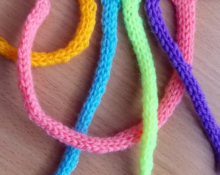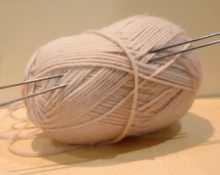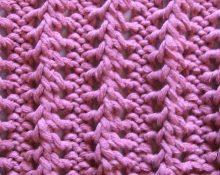You've probably noticed that when casting on loops in the usual way, the edge looks, to put it mildly, differently than on factory items. And if on one side it is neat, then on the other side of the canvas a chain of loops is clearly visible. When knitting the stockinette stitch, it still looks normal, but in the case of an elastic band, the other edge just asks for it.

@YouTube
Italian set of elastic loops: what are the features?
The main difference between this method is the formation of a well-stretching and elastic edge. It is somewhat more complicated than a regular set. But with the proper experience and skill, you can do it quickly and efficiently. One of the secrets is to use knitting needles of a smaller diameter than for the main fabric. I will tell you about all the other nuances further, describing different options for performing the technique.
Method of dialing for elastic bands 1*1 and 2*2
Using this method, you can knit both types of elastic bands. For 1*1 you need to cast on a multiple of 2 loops, for an elastic band 2*2 - a multiple of 4. To work you will need knitting needles of two sizes with half number increments.The set of loops is made on smaller knitting needles.
- We type the first paragraph using any convenient and in the usual way.
- Wrap one of the threads (when casting on there are, as it were, two - the main thread and the end of the thread, separated by the first loop) around the thumb, the second - around the index finger.
- Place the knitting needle behind the thread from the index finger and under the thread from the thumb. The result is a loop with a jumper - purl.
- Knitting needle under the thread from the thumb, grab the thread from the index finger. The result is a loop similar to a yarn over - the front one.
- Continue casting on knit and purl stitches in this manner, casting on the last one in the usual way - there will be another edge stitch.
- We remove the edge stitch, and we also remove the next stitch with the jumper (purl) with the thread before work. We knit the next (front) stitch. We knit this way to the end, we knit the last edge stitch with a purl. We knit the next row in the same way. In total you need to knit from 2 to 4 rows with a double elastic band.
- As a result, we will get a very smooth, elastic, rounded edge. After knitting a double elastic band, you can proceed to knitting an elastic band 1*1, 2*2 and generally any pattern. Don't forget to change your knitting needles to thicker ones.
Advice! Use this set if you are knitting fabric in stockinette stitch. Then the edge of the product will not be wrapped.

@marijakarmanova.blogspot.com
Circular Italian loop set
For knitting in the round, consider a slightly different method from the previous one. For this, I first take a thinner knitting needle, placing the end of the thread on my thumb, and the part leading to the skein on my index finger (as if stretching it between my fingers). We take a smaller knitting needle, grab the thread, move it slightly to the side and turn it around its axis (so that the knitting needle points up). This will be the first loop.
- Holding the loop, we insert the knitting needle under the thread from the thumb, pick it up from the index finger and move it to the side. It turns out like a facial loop.
- We insert the knitting needle under the thread from the index finger, pick up the thread from the thumb and pull it back. So we cast on the required number of loops.
- Cast on the last stitch using any method.
- We straighten all the loops, make sure they are not twisted and connect them into a circle. To do this, transfer the first stitch cast on from the left to the right needle, and transfer the last stitch over it. Return the first cast-on stitch to the left needle and tighten the threads. Turn the knitting 180 degrees.
- We knit 1 row of double elastic - we remove the purls with the working thread in front, we knit the knits with the knits.
- In the second row we knit the purl stitches purlwise, and remove the knit stitches with the thread while working. We knit two more rows in this way.
- We switch to the elastic band of your choice. Here the first loop is purl - we knit it this way: behind the back wall, and the front one - behind the front. After the first row with the main pattern, we move on to knitting needles of larger diameter.

Set of loops with elastic edge on additional thread
In my opinion, it is easier to do an Italian cast-on using an additional thread. To do this, a contrasting thread is usually used to make it easier to remove later. You should cast on half as many loops as you need to knit the fabric, and one extra. We cast on these loops in any convenient way on knitting needles half a size smaller than we plan to knit the main fabric. Then it is better to tie the ends of the thread into a knot to secure the last loop cast on. After this, you need to take the main thread and start knitting in the following way:
- Knit the first stitch - this will be the edge stitch.
- We also knit the second loop and then yarn over.
- Repeat step 2 until the end of the row.
- In the next row you need to start knitting a hollow elastic band. To do this, knit the edge loop (you can also remove it), knit the yarn over, remove the next (purl) loop with the thread before work. Knit 1 or 3 more rows like this: an even number of rows should be knitted with a hollow elastic band.
- After this, we knit the required pattern, changing the knitting needles to the main ones, and after several knitted rows, the additional thread can be removed - unraveled or cut.
Using an Italian set of loops you can create a very beautiful and elastic edge. It is somewhat more complicated to perform, but once you learn it, you will never return to a simple set. I have described several possible options - you choose the one that is most convenient for you and use it with pleasure.


 0
0





